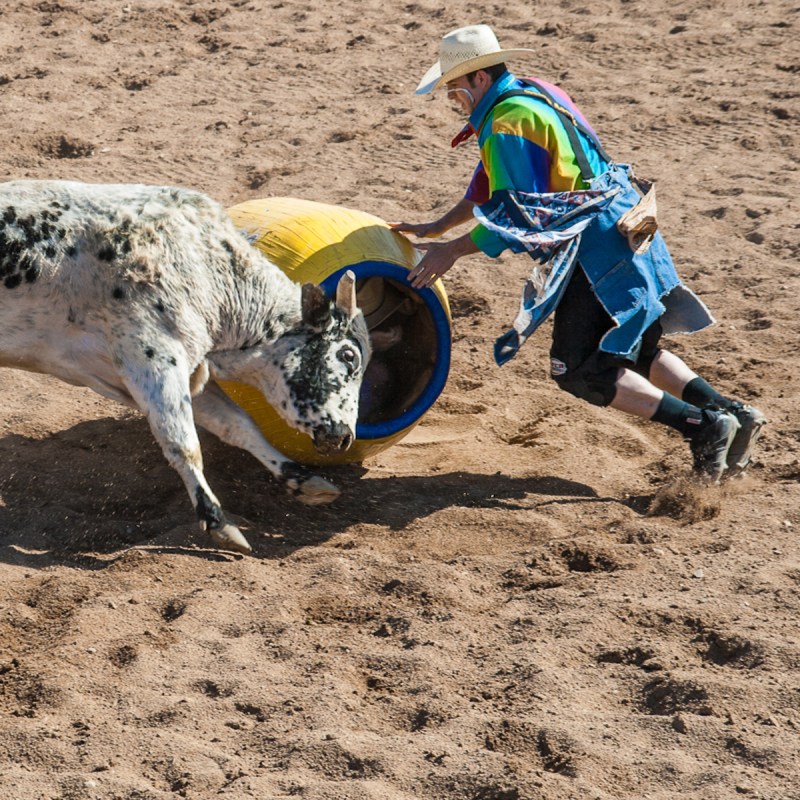
If you travel anywhere in the West or Northwest, you’ll probably have an opportunity to see a rodeo. I live in Arizona and have been attending and photographing rodeos for 10 years. I see around two or three per season and often see people who are bewildered because they don’t know what to expect and don’t understand the events or the scoring. So, if you plan to go to a rodeo, here are some things to know to help you make the most of the experience.
Videos by TravelAwaits

1. Some Offer More Than The Main Event
Most rodeos offer entertainment leading up to and during the main event, such as a parade, carnival rides and games, a concert, an air show, or a dance. Many also include Mutton Busting, children’s rodeo events where kids compete to see who can ride a sheep the longest.
Annual rodeos like Cheyenne Frontier Days and the Calgary Stampede draw thousands each year and feature a parade, carnival, and musical entertainment from top acts like Garth Brooks, George Strait, Aerosmith, Luke Bryan, and Miranda Lambert. Cheyenne Frontier Days features an air show, and you can see a dog show at the Calgary Stampede.
La Fiesta de los Vaqueros in Tucson, Arizona, lasts for a week each February, and its rodeo parade is the longest non-motorized (horse-drawn) parade in the world. In Cave Creek, Arizona, a parade kicks off the week-long Rodeo Days festivities, along with a dance the same evening. There’s also a golf tournament during the week.

2. Dress Comfortably
Bust Out Your Western Wear
You can wear just about anything you want to a rodeo but err on the side of comfort. You’ll be doing a lot of walking on (sometimes) uneven terrain. So, comfortable shoes are a must. You’ll also be sitting on wood or metal bleachers.
If you identify with the Toby Keith hit “Should’ve Been a Cowboy” or need a socially acceptable reason to wear a cowboy hat, you’ll feel at home at a rodeo. Wear your cowboy hat, embroidered shirt, turquoise jewelry, and belt buckles with pride, and don’t forget your cowboy boots. If you don’t own any Western wear, there are always vendors who sell cowboy clothing and accessories.

3. Rough Stock Events
A professional rodeo includes rough stock and timed events. Official rough stock events include bareback riding, saddle bronc riding, and bull riding. To get a score, contestants must stay on a bucking bull or horse for at least 8 seconds.
Contestants are scored by two judges who award 50 points each — 25 to the rider and 25 to the animal. Horses and bulls are judged by their bucking action. Riders are judged on their spurring ability and how well they move with the horse and deal with multiple twists and turns. If a horse or bull isn’t active enough, the contestant is offered a “do-over” on a different animal.
- Bareback Riding: Contestants ride a bronc (unbroken horse) while holding onto a leather rigging that resembles a suitcase handle. Riders must pull their knees up and roll their spurs on the horse’s shoulders. They’re disqualified if they straighten their legs before the horse’s feet hit the ground.
- Saddle Bronc Riding: Contestants sit in a saddle on a bronc, hold a thick rein attached to the horse’s halter, and synchronize their movements with the horse’s. The rider must stay in the saddle and hold the rein with one hand. They’re disqualified if they touch the horse or their own body with their free hand.
- Bull Riding: Contestants hold a flat braided rope and must stay on a two-ton bull that bucks, turns, jumps, and twists while only using one hand to hang on. They’re disqualified if their other hand touches the bull.

4. Timed Events
Timed events include steer wrestling, team roping, tie-down roping, and barrel racing. Contestants race against the clock to get the shortest time.
Contestants pay to compete in each event, and every cowboy and cowgirl aspires to be one of the top 15 contestants in their event based on money won during the regular season so they can qualify for the National Finals Rodeo that’s held in Las Vegas each December.
- Tie Down Roping: A contestant chases and ropes a calf and dismounts while his horse stops. He picks up the calf, places it on the ground on its side, ties any three legs together, and throws his hands up in the air. Then he remounts his horse and rides forward to add slack in the rope. If the calf remains tied for 6 seconds, he receives a score. If the calf kicks free, he receives no time. If the contestant doesn’t allow the calf to get a good head start, he receives a 10-second penalty.
- Steer Wrestling: A contestant chases a steer, slides off a galloping horse, hooks the steer’s right horn with his arm, grasps the left horn with his left hand, and wrestles it to the ground. The steer must be on its side with all four feet pointing in the same direction. If he fails to allow the steer a good head start, he’s assessed a 10-second penalty.
- Team Roping: Two cowboys or cowgirls who are skilled riders and ropers chase a steer. The first person (the header) ropes the steer around the head, neck, or horns and guides the steer to the left to expose its hind legs so the second person (the heeler) can rope them. Once both team members move so there’s no slack in the rope and their horses face each other, officials stop the clock and record the score. If the contestants don’t allow the steer enough of a head start, the team receives a 10-second penalty. The team gets a 5-second penalty if the heeler only ropes one of the steer’s feet.
- Barrel Racing: This is the only event where the ladies take center stage, and speed and horse(wo)manship are the name of the game. Contestants ride around three barrels placed in a triangle in a cloverleaf pattern and back to the starting point. Tipping a barrel is okay, but if a barrel falls over, the rider gets a 5-second penalty. An electronic eye marks when the race begins and ends, and times are recorded to the hundredth of a second.

5. Novelty Acts Between Events
Most rodeos feature novelty acts such as trick roping and riding between events. One or more clowns also banter with the announcers to entertain the crowd during and between events. However, rodeo clowns also have the much more important job of distracting angry bulls so they don’t attack contestants, workers, or field judges. During the bull riding event, they run after bulls to help guide them toward the exit and use large barrels to avoid being gored.
History Of The Rodeo
After the Civil War, Southwest ranchers organized cattle drives to train stations to transport animals east. Cowboys needed a wide variety of skills to wrangle cattle. So, they entertained themselves in their free time by competing against each other to see who had the best riding and roping skills.
By the late 19th century, rodeo was a popular spectator event throughout the American West. In 1945, the Professional Rodeo Cowboys Association (PRCA) was organized to monitor eligible events and standardize rules. Other rodeo associations, including the Women’s Professional Rodeo Association (WPRA), were established midway through the 20th century to institutionalize and legitimize the sport.
Today, rodeos are serious sporting events, and human and animal competitors are seen as athletes on the same level as NFL quarterbacks and NBA pitchers. Fans have a deep knowledge of the events and come with scorecards and signs to support their favorite cowboys and cowgirls.
Rodeo is the official state sport of three states: Texas, South Dakota, and Wyoming. It is so important to Wyoming that a bucking horse and rider is the state’s registered trademark.
Where To See A Rodeo
Rodeo season runs from spring through fall and culminates with the National Finals in December. Check the schedule to find a rodeo near you or in the area you plan to visit. It’s also important to consider the time of year. Outdoor rodeos in Arizona and Texas are usually held in the spring before the weather becomes too hot.
- Fort Worth, Texas, hosts the world’s only year-round rodeo each weekend at the historic Fort Worth Cowtown Coliseum.
- Cheyenne Frontier Days and the Calgary Stampede are in July.
- Tiny Cody, Wyoming, hosts the longest-running and only nightly rodeo from June through August every year.
Next time a rodeo comes to your area, or you’re traveling in the American West, buy a ticket, don your cowboy hat and boots, and have fun watching the skill of both two- and four-legged competitors. Happy trails!
Related Reading:
